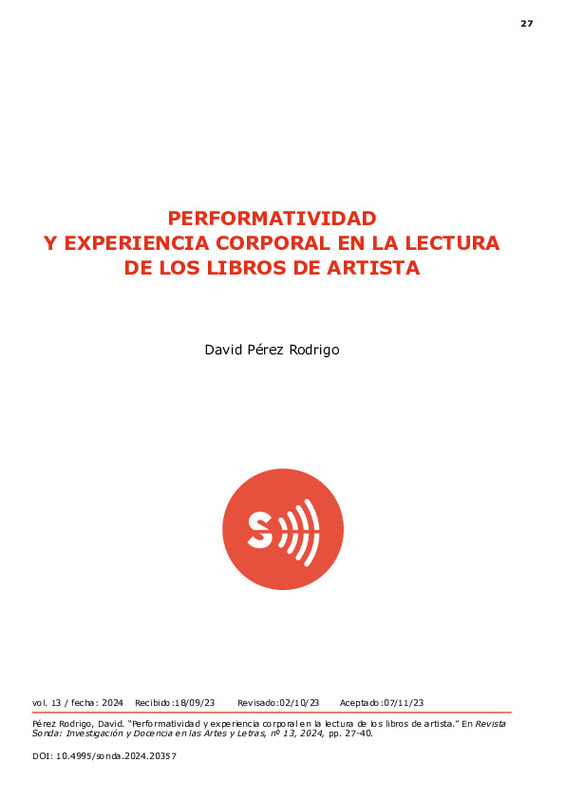|
Resumen:
|
[EN] Artist s books and texts, whether individual or collective, start from an obvious common point: both have a textual nature and are authored by artists. However, in their conceptual approaches and in their formal ...[+]
[EN] Artist s books and texts, whether individual or collective, start from an obvious common point: both have a textual nature and are authored by artists. However, in their conceptual approaches and in their formal resolutions, these two discursive realities present differences and specificities that (being also very evident) are paradoxical. This fact is due to the fact that both phenomena conform to polyform typologies. The consequence generated by this circumstance is the discursive promiscuity and multiplicity that is easily observed both in the texts and in the artist s books. If in 2012 we were able to analyze the types of artist texts in the volume Dicho y hecho. Textos de artista y teoría del arte, at this time we want to raise this phenomenon in artist s books. Now, studying this reality as a whole is something that has been carried out recently by Professor Javier Maderuelo in the book Arte impreso, published in 2018. In this detailed study, the author performs an analysis of the artist s book, placing it within a broader and more comprehensive classification. This classification is the one used in the title of his study, since it groups all the existing diversity within the field of artistic publishing, self-publishing and printing. His undoubted contribution means that this article is not directed towards that objective. Our analysis, on the contrary, wishes to raise a specific question of the artist s book. And to do it, moreover, taking as reference two works by two women conceptual artists: Esther Ferrer (San Sebastián, 1937) and Fina Miralles (Sabadell, 1950). The specific question alluded to focuses on the performative sense that the concept of reading applied to the artist s book arouses. A concept that, when interpreted from corporeality and physicality, we try to base taking as a reference a philosophical approach that is based, especially, on the contributions of Maurice Merleau-Ponty and Jacques Derrida.
[-]
[ES] Los libros y los textos de artista, ya sean individuales o colectivos, parten de un punto común evidente: ambos poseen un carácter textual y una autoría realizada por artistas. No obstante, en sus planteamientos ...[+]
[ES] Los libros y los textos de artista, ya sean individuales o colectivos, parten de un punto común evidente: ambos poseen un carácter textual y una autoría realizada por artistas. No obstante, en sus planteamientos conceptuales y en sus resoluciones formales estas dos realidades discursivas presentan diferencias y especificidades que, siendo también muy evidentes, resultan paradójicas. Este hecho se debe a que ambos fenómenos se ajustan a tipologías poliformes. La consecuencia que genera esta circunstancia es la promiscuidad y multiplicidad discursivas que fácilmente se observa tanto en los textos como en los libros de artista. Si en el año 2012 pudimos analizar las tipologías de textos de artista en el volumen Dicho y hecho. Textos de artista y teoría del arte, en estos momentos deseamos plantear este fenómeno en los libros de artista. Ahora bien, estudiar en su conjunto esta realidad es algo que ha sido efectuado recientemente por el profesor Javier Maderuelo en el libro Arte impreso, publicado en 2018. En este pormenorizado estudio el autor realiza un análisis del libro de artista, situándolo dentro de una clasificación más amplia e integral. Esta clasificación es la utilizada en el propio título de su estudio, ya que la misma agrupa toda la diversidad existente dentro del ámbito de edición, autoedición e impresión artísticas. Su indudable aportación hace que el presente artículo no se dirija hacia ese objetivo. Nuestro análisis, por el contrario, desea plantear una cuestión específica del libro de artista. Y hacerlo, además, tomando como referencia dos obras de dos mujeres artistas conceptuales: Esther Ferrer (San Sebastián, 1937) y Fina Miralles (Sabadell, 1950). La cuestión específica aludida se centra en el sentido performativo que suscita el concepto de lectura aplicado al libro de artista. Un concepto que, al ser interpretado desde la corporalidad y la fisicidad, intentamos fundamentar tomando como referencia un planteamiento filosófico que se basa, especialmente, en las aportaciones de Maurice Merleau-Ponty y Jacques Derrida.
[-]
|









